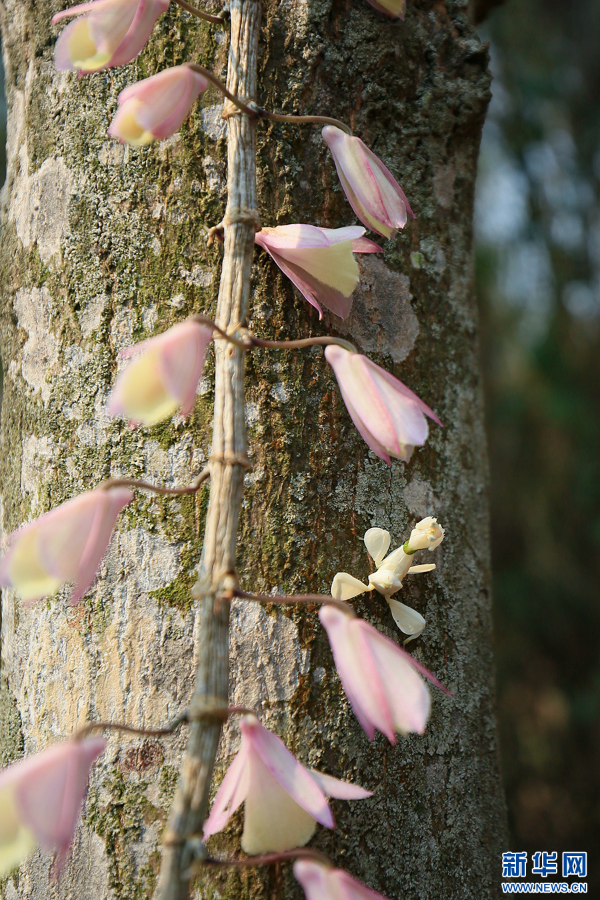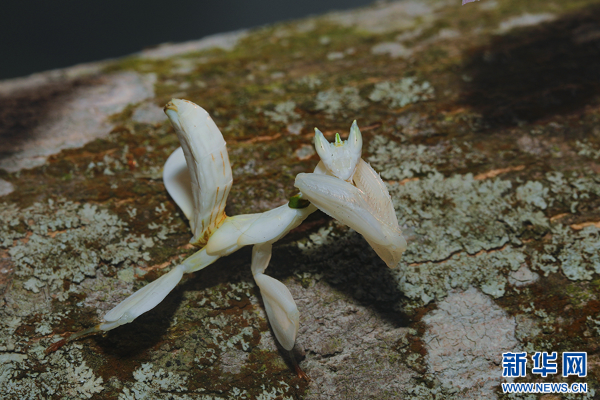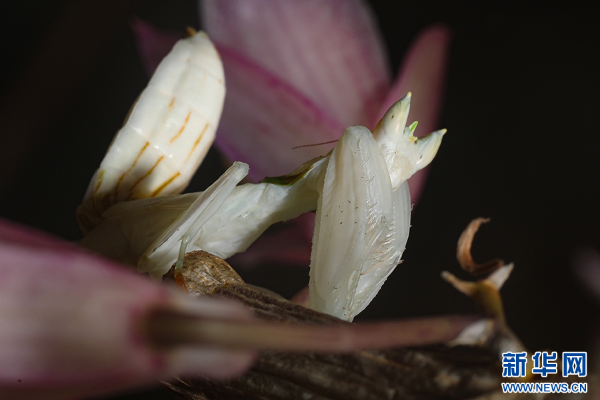Dancing "Flower Fairies" in Xishuangbanna's Asian Elephant National Park
Source: InKunming | 2025-02-25 | Editor:Jennifer
In the mysterious and diverse Candidate Area of Xishuangbanna's Asian Elephant National Park, there lives a "master of camouflage." Imagine a delicate, vibrant "flower" swaying gently in the breeze within a dense rainforest, as if dancing. Upon closer look, you discover it is an insect. Isn't that amazing? Indeed, it's the orchid mantis.

The "Queen of Insects" - The Orchid Mantis (File photo)
Spring is the season when the orchid mantis is born. When this magical little creature is born in the rainforest, it interacts with the ecosystem in ways that are nothing short of fascinating. Let's take a closer look at this dancing "flower fairy" and the "beauty representative" of the mantis family.
Hello everyone, I'm "Jingjing", an Asian elephant living in the Candidate Area of Xishuangbanna’s Asian Elephant National Park. Today, I'll unveil the mystery of the orchid mantis for you. The orchid mantis, known scientifically as Hymenopus coronatus, is often discussed in recent years, but they are not commonly seen. Spotting a wild orchid mantis requires both luck and fate.

The first encounter with an orchid mantis feels like stumbling upon a dreamlike wonder in the rainforest. Its body is light and elegant, with four slender legs resembling meticulously carved petals. Its main body is snow-white, adorned with scattered pink and golden spots.

As it grows, the orchid mantis undergoes color changes. Newly hatched mantises typically display a striking combination of red and black. After the first molt, their body colors shift to a mix of white and pink, resembling orchid hues. As they mature, the pink color gradually fades, replaced by brown spots, and their body transitions from creamy white to light yellow.

Of course, the orchid mantis is named not only for its orchid-like color but also for its flower-like shape. When it rests on an orchid, it blends beautifully with its surroundings; when it moves, it sways like a flower in the breeze, appearing to dance as a "flower fairy." This is why the orchid mantis is considered the "beauty representative" of the mantis family, earning the title "Queen of Insects."

The Orchid Mantis camouflaged among dendrobium flowers (File Photo)
An art of camouflage and survival
The orchid mantis has a small, delicate head with a pair of shiny black eyes that resemble lively little beans, always alert to its surroundings. When it rests on a flower, its antennae sway slightly, mimicking the flower's stamens trembling in the wind, making it hard to distinguish whether it's a flower or an insect. This unique appearance serves as a survival tool, giving them an edge as skilled predators.

Orchid mantises are carnivorous insects, primarily feeding on small insects like drosophilidaes, bees, and butterflies. When hunting, they patiently hide among flowers, using their camouflage to remain motionless and wait for prey to come within reach. Once the prey is close enough, the orchid mantis strikes instantly, using its powerful forelimbs to catch its prey securely.

Orchid mantises thrive in warm, humid, and densely vegetated environments, making the Candidate Area of Xishuangbanna's Asian Elephant National Park and Pu'er area ideal homes for them. They blend beautifully with the surrounding flowers, which not only helps them evade predators but also cleverly lures prey. When small insects are attracted to this "beautiful flower," the orchid mantis launches a lightning-fast attack, turning the entire hunting process into a captivating performance.

Additionally, the orchid mantis has a hidden skill—gliding. Research has shown that its unique flower-like leg flaps play a crucial role in gliding. This discovery, published in the renowned international journal "Current Biology," has given scientists new insights into this fascinating creature. Whether it's camouflage or gliding, the orchid mantis never fails to amaze.

A key player in the ecosystem
The orchid mantis is not only a "star" of the rainforest but also an indispensable part of the ecosystem. They are active during the day and seek relatively safe places to rest at night. Moreover, they exhibit territorial behavior, guarding their chosen flower patches and preventing other mantises from intruding.

The orchid mantis resting on a tree trunk (File Photo)
The presence of the orchid mantis reflects the complexity and diversity of the tropical rainforest ecosystem. Their unique survival strategies and behaviors play a vital role in maintaining ecological balance. As a result, they have become an important species for studying biodiversity and ecological health.

An orchid mantis camouflaged among Dendrobium flowers (File Photo)
Despite their fascinating nature, the survival of orchid mantises is under threat. Let's work together to protect these magical little creatures and their habitats, ensuring that the enchanting stories of the tropical rainforest continue to unfold.
Click here to view the Chinese report
(Editors: Ines, Jennifer)
You May Like
-
First visa-free ASEAN tour group enters China's Xishuangbann...
On Tuesday evening, a group of 15 tourists from Thailand and Laos walked out of the China-Laos Railway's Xishuangbanna station, greeted by a water-splashing cer...
InKunming 2025-02-19 -
South and Southeast Asian Media Network Annual Meeting 2024 ...
December 9, the South and Southeast Asian Media Network (SSAMN) Annual Meeting 2024 was held in Xishuangbanna Dai Autonomous Prefecture, Yunnan Province. Duri...
InKunming 2024-12-10 -
Giant water lilies a big hit in Xishuangbanna
Lightweight tourists step onto the pads of giant water lilies, which resemble China's traditional emerald-jade plates on the surface of a pond, and magically fi...
InKunming 2023-08-29 -
Xishuangbanna Wild Elephant Valley: a Natural Paradise
Under the warm winter sun, dozens of elephant keepers and managers in green clothes sat in a circle in the open space close to the elephant staple of Xishuangba...
InKunming 2022-12-12 -
Fireflies dancing in the forests of Xishuangbanna
Xishuangbanna Tropical Botanical Garden, Chinese Academy of Sciences, is one of the viewing sites for fireflies in China in terms of the most abundant species...
InKunming 2022-04-28 -
What makes Xishuangbanna one of the best regions to visit in...
Xishuangbanna, one of the eight autonomous prefectures in southwest China's Yunnan Province, has made it to the list of Lonely Planet's top 10 regions to visit ...
InKunming 2021-11-24 -
China Eastern Airlines to start a new route between Xishuang...
On April 15, the reporter was informed from China Eastern Yunnan Airlines that the company will start a new route between Xishuangbanna and Baoshan in Yunnan ...
InKunming 2020-04-16 -
World Elephant Day event held in Xishuangbanna to protect As...
[InKunming--Yunnan]Morethan20Asianelephantsenjoyedbananas,applesandcarrotsfedbyvolunteersattheWildElephantValleyscenicspotinYunnan’sXishuangbannaonAugust12
InKunming 2019-08-18 -
Meet nature's wonder in Xishuangbanna Botanical Garden
InKunming 2019-07-01 -
3rd Daile Culture Festival to be celebrated in Feb. in Xishu...
InKunming 2019-01-15







